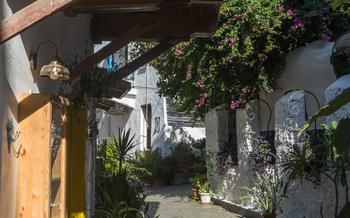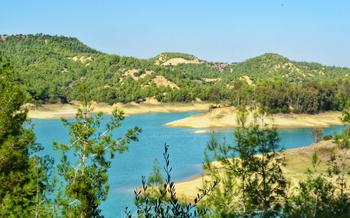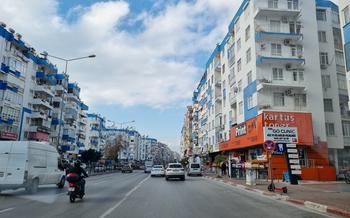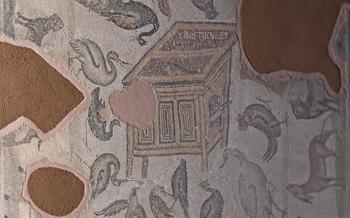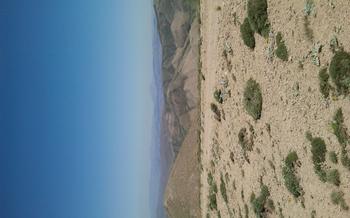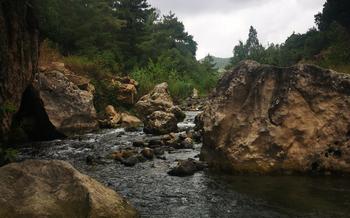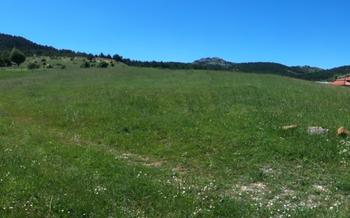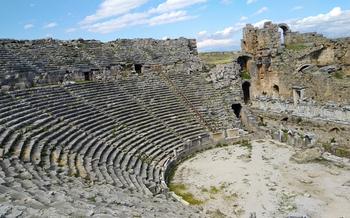
Ancient City of Castabala
- The Antiquity of Castabala: A Journey Through Time
- Exploring the Ruins of Castabala: A Walk Through History
- Castabala's Enduring Legacy: A Testament to Resilience
- The Amphitheatre of Castabala: Echoes of Ancient Spectacles
- Castabala's Fortifications: A Symbol of Strength and Defense
- The City of Churches: Unveiling Castabala's Religious Past
- The Mosaics of Castabala: Masterpieces of Ancient Art
- Castabala's Necropolis: A Window into Ancient Burials
- Castabala's Aqueduct: A Marvel of Engineering
- The Castabala Museum: A Treasure Trove of Discoveries
- Local Cuisine: Savoring the Flavors of Adana in Castabala
- Festivals and Events: Unveiling Castabala's Cultural Vibrancy
- Off the Beaten Path: Exploring Hidden Gems in Castabala
- Insider Tip: A Secret Panorama
The Antiquity of Castabala: A Journey Through Time
Castabala, nestled in the heart of ancient Cilicia, was a city of profound historical significance. Its roots stretch back to the 4th century BC, when it served as a vital hub for trade and commerce. Alexander the Great's conquests brought it under Hellenistic rule, leaving an indelible mark on its culture and architecture. Castabala flourished under Roman rule, becoming a prominent city in the province of Cilicia Secunda. Archaeological excavations have unearthed a treasure trove of artifacts, including inscriptions, coins, and pottery, shedding light on the city's rich past. Castabala's strategic location made it a focal point for major historical events, including the Cilician revolt against the Romans in the 1st century AD and the Arab conquest in the 7th century AD. Its architectural legacy, including the impressive city walls, amphitheater, and churches, stands as a testament to its enduring influence.
Exploring the Ruins of Castabala: A Walk Through History
Castabala's ruins stand as a testament to its glorious past, inviting visitors to embark on a captivating journey through time. The city walls, once formidable barriers, now provide a glimpse into Castabala's strategic importance. Explore the intricate network of streets, where ancient footsteps once echoed, and discover hidden gems tucked away among the ruins.
The Castabala Amphitheater, a marvel of architectural ingenuity, awaits exploration. Imagine the roar of the crowd as gladiators clashed in fierce combat or the melodies of musicians filling the air during grand performances. The acoustics of this ancient venue are still remarkable, allowing visitors to experience the ambiance of a bygone era.
Unearth the secrets of Castabala's rich history through the artifacts discovered amidst its ruins. From pottery shards that reveal daily life to inscriptions that narrate epic tales, each artifact holds a piece of the city's story. As you wander through the ruins, let your imagination soar, and envision the bustling streets and vibrant community that once thrived within these ancient walls.
Castabala's Enduring Legacy: A Testament to Resilience
Castabala's influence extended beyond its immediate borders, playing a pivotal role in the ancient world. As a bustling trade center, it facilitated the exchange of goods and ideas, connecting diverse cultures and economies. Its strategic location along trade routes made it a hub for merchants and travelers, contributing to the city's prosperity.
Moreover, Castabala's political significance cannot be underestimated. As a part of various empires and kingdoms, it served as an administrative and military center. Its strategic position made it a key player in regional conflicts and power struggles. The city's fortifications and military prowess ensured its resilience and ability to withstand attacks and invasions.
Castabala's enduring legacy lives on through historical records and legends. Ancient texts and inscriptions provide valuable insights into the city's history, culture, and achievements. Legends and tales passed down through generations speak of its grandeur, its triumphs, and its fall. These narratives serve as a testament to the city's enduring impact on the region's collective memory.
The rise and fall of Castabala offer valuable lessons for contemporary society. It reminds us of the impermanence of power and the cyclical nature of history. The city's legacy teaches us the importance of resilience, adaptation, and the preservation of cultural heritage. By studying and appreciating Castabala's past, we can gain insights into our own society and strive to build a sustainable future.
The Amphitheatre of Castabala: Echoes of Ancient Spectacles
In the heart of ancient Castabala, the amphitheatre stands as a testament to the city's love for entertainment and spectacles. Built in the 2nd century AD, this magnificent structure echoes with the voices of gladiators, the roar of the crowd, and the thrill of chariot races. Enter the arena and admire its elliptical shape, capable of accommodating thousands of spectators in its tiers of seating.
The amphitheater's design showcases remarkable acoustics, ensuring that every sound reverberates throughout the venue. Imagine the thunderous applause, the cheers of victory, and the collective gasps of suspense as ancient dramas unfolded before the eyes of Castabala's citizens. Step onto the stage and envision gladiators engaging in fierce combat, chariots speeding around the track, and actors bringing myths and legends to life.
While much of the amphitheater's original grandeur has been weathered by time, its evocative atmosphere remains palpable. Close your eyes and let your imagination transport you back to a time when Castabala's amphitheatre was alive with the energy of spectacles, where every performance was a celebration of human skill, courage, and artistry.
Castabala's Fortifications: A Symbol of Strength and Defense
The impressive city walls of Castabala stand as a testament to its strength and strategic importance. Constructed using massive blocks of stone, these fortifications formed an impenetrable barrier against invaders. The walls were further reinforced with towers and gateways, each serving a specific defensive purpose. The towers provided elevated platforms for archers and sentries, allowing them to keep watch over the surrounding landscape. The gateways, on the other hand, were carefully designed to control access to the city and could be easily blocked in times of danger. The construction techniques employed in Castabala's fortifications demonstrate the advanced engineering skills of its builders. The walls were constructed using a combination of large and small stones, creating a sturdy and durable structure. Moreover, the use of interlocking joints ensured that the walls would remain stable even under the most adverse conditions. These fortifications played a crucial role in protecting Castabala's people and preserving its independence, making them a symbol of the city's resilience and strength.
The City of Churches: Unveiling Castabala's Religious Past
Nestled amidst the ancient ruins of Castabala, a remarkable collection of churches stands as a testament to the city's rich religious heritage. These sacred structures, each possessing unique architectural styles and features, offer a glimpse into the profound role Christianity played in shaping Castabala's society.
The most prominent among these churches is the grand Basilica, its imposing size and intricate design captivating visitors. With its soaring columns, arched windows, and intricate mosaics, the Basilica exudes an aura of grandeur and devotion. Within its walls, the faithful once gathered for worship, their voices resonating through the centuries.
Other notable churches in Castabala include the Church of the Apostles, known for its well-preserved frescoes depicting biblical scenes, and the Church of St. George, with its unique circular design and stunning stained-glass windows. These churches, though smaller in size, hold equal significance in revealing the diverse expressions of Christian faith in Castabala.
Exploring these sacred spaces, one can't help but be transported back in time, imagining the rituals, prayers, and celebrations that once filled their hallowed halls. The churches of Castabala stand as silent witnesses to the deep spirituality and religious fervor that permeated the lives of its ancient inhabitants.
The Mosaics of Castabala: Masterpieces of Ancient Art
Among the ruins of Castabala, exquisite mosaic artworks have been discovered, adding another layer of beauty and artistry to this ancient city. These mosaics, crafted by skilled artisans, showcase a variety of techniques, materials, and themes, offering a glimpse into Castabala's rich cultural and artistic heritage.
The mosaics of Castabala are renowned for their intricate designs, vibrant colors, and symbolic meanings. Geometric patterns, floral motifs, and scenes depicting mythological figures, animals, and everyday life adorn the floors and walls of various buildings throughout the city. Each mosaic is a unique masterpiece, telling a story and conveying hidden messages.
The materials used in the mosaics are as diverse as the designs themselves. Small, colorful tesserae made from stone, glass, and ceramic were meticulously arranged to create these intricate works of art. The skillful combination of different materials and techniques resulted in mosaics that have stood the test of time, retaining their brilliance and beauty despite centuries of wear and tear.
Beyond their aesthetic appeal, the mosaics of Castabala provide valuable insights into the city's religious beliefs, cultural influences, and daily life. They depict scenes from Greek mythology, Roman imperial iconography, and Christian symbolism, reflecting the diverse influences that shaped Castabala's society.
The mosaics of Castabala are not only visually stunning but also serve as historical documents, offering glimpses into the minds and hearts of the people who lived in this ancient city. They are a testament to the creativity, skill, and artistry of Castabala's artisans and continue to inspire and captivate visitors to this day.
Castabala's Necropolis: A Window into Ancient Burials
Nestled on the outskirts of ancient Castabala lies a fascinating necropolis, a city of the dead that offers a glimpse into the burial customs and beliefs of its inhabitants. The necropolis, which dates back to the Roman period, is a treasure trove of archaeological discoveries, providing insights into the lives and afterlife rituals of Castabala's ancient population.
The tombs in the necropolis vary in size and design, reflecting the social status and wealth of the deceased. Some tombs are simple rock-cut chambers, while others are elaborate structures with multiple rooms and painted decorations. Among the most notable tombs is a large family mausoleum, which features a series of interconnected chambers adorned with intricate carvings and frescoes.
One of the most intriguing aspects of the necropolis is the presence of grave goods, which were buried alongside the deceased to accompany them on their journey to the afterlife. These goods include jewelry, pottery, tools, and even food offerings. The types of grave goods found in each tomb provide clues about the individual's social status, occupation, and personal preferences.
By exploring the necropolis of Castabala, visitors can gain a deeper understanding of the beliefs and practices surrounding death and burial in the ancient world. The necropolis serves as a poignant reminder of the city's rich history and the lives of its people, who, even in death, continue to captivate the imagination of modern-day travelers.
Castabala's Aqueduct: A Marvel of Engineering
Castabala's impressive aqueduct system stands as a testament to the engineering prowess of its ancient builders. This marvel of ancient engineering played a crucial role in sustaining life and economic activities within the city. The aqueduct's intricate network of channels and pipes transported water from distant sources, ensuring a reliable supply for Castabala's growing population.
The construction of the aqueduct involved meticulous planning and skillful execution. Engineers carefully surveyed the landscape to determine the most efficient route for the water to flow. They employed sophisticated techniques to maintain a consistent gradient, allowing water to flow smoothly without losing pressure. The aqueduct's construction involved the use of durable materials such as stone and mortar, ensuring its longevity.
The aqueduct not only provided a vital water source for Castabala's residents but also contributed significantly to the city's economic prosperity. The abundant water supply facilitated agriculture, allowing farmers to cultivate crops and raise livestock more efficiently. The aqueduct also supported various industries and trade activities, as water was essential for many manufacturing processes.
Today, the remains of Castabala's aqueduct serve as a poignant reminder of the city's ingenuity and the importance of water in ancient societies. As you explore the ruins of Castabala, take a moment to appreciate the remarkable engineering feat that brought life-giving water to this thriving ancient metropolis.
The Castabala Museum: A Treasure Trove of Discoveries
Nestled in the heart of Castabala, the Castabala Museum stands as a testament to the city's rich history and cultural heritage. Within its walls, a treasure trove of artifacts awaits visitors, offering a glimpse into the lives and achievements of Castabala's ancient inhabitants.
The museum's collection boasts an impressive array of sculptures, pottery, and other artifacts meticulously unearthed during archaeological excavations at the ancient city. Among the highlights are exquisite marble statues, intricately carved reliefs, and ceramic vessels adorned with vibrant designs.
Each artifact in the museum tells a story, providing valuable insights into Castabala's artistic traditions, religious beliefs, and daily life. From finely crafted jewelry to bronze tools, the exhibits showcase the remarkable craftsmanship and ingenuity of the city's artisans.
A visit to the Castabala Museum is an essential experience for anyone seeking to delve deeper into the history and culture of this ancient metropolis. Whether you're an avid history enthusiast, an art lover, or simply curious about the past, the museum offers a fascinating journey through time.
To maximize your visit, consider joining a guided tour led by knowledgeable museum staff who can provide expert insights into the exhibits and bring the ancient world to life. Don't forget to take your time to admire the intricate details and symbolism embedded in each artifact, as they hold the key to understanding Castabala's enduring legacy.
Local Cuisine: Savoring the Flavors of Adana in Castabala
Castabala's culinary heritage is a testament to its rich history and cultural influences. As you explore the ancient ruins, be sure to tantalize your taste buds with the delectable dishes that reflect the region's unique flavors.
Adana, the province where Castabala is located, is renowned for its culinary delights. The city's cuisine boasts a blend of Turkish, Arabic, and Kurdish influences, creating a symphony of flavors that will captivate your senses.
One must-try dish is the "Adana Kebab", a succulent skewer of minced lamb grilled to perfection. The smoky aroma and juicy texture of this kebab are sure to leave you craving for more.
For a taste of local vegetarian cuisine, sample the "Cacık", a refreshing yogurt-based dip made with finely chopped cucumbers, garlic, and fresh herbs. This cooling dish is the perfect accompaniment to grilled meats or as a light and healthy snack.
No visit to Castabala is complete without indulging in the "Şırdan", a local delicacy made from lamb stomach stuffed with rice, spices, and herbs. This unique dish is a testament to the region's culinary creativity and is sure to challenge your palate.
To satisfy your sweet tooth, try the "Katmer", a flaky pastry filled with nuts, sugar, and cinnamon. This dessert is a popular treat in Castabala and is often served with a cup of Turkish coffee or tea.
When searching for authentic culinary experiences, venture beyond the tourist traps and seek out local markets and restaurants frequented by locals. Here you'll find fresh ingredients, traditional cooking methods, and the warmth of Turkish hospitality.
Embrace the opportunity to engage with the locals, learn about their culinary traditions, and savor the flavors that make Castabala a gastronomic gem.
Festivals and Events: Unveiling Castabala's Cultural Vibrancy
Castabala comes alive during its annual festivals and events, showcasing the city's rich cultural heritage and traditions. The most notable celebration is the Castabala Culture and Arts Festival, held every summer. This vibrant festival features traditional music and dance performances, art exhibitions, and historical reenactments that transport visitors back in time.
The Castabala Grape Festival, held in September, celebrates the region's famous vineyards and winemaking traditions. Visitors can indulge in grape-based delicacies, witness traditional grape stomping, and join in the lively festivities that fill the streets of Castabala.
For those interested in religious traditions, the Feast of Saint George, held on May 6th, is a significant event in Castabala. Devotees gather at the ancient Church of Saint George to honor the patron saint of the city, participating in special prayers, processions, and communal meals.
Throughout the year, Castabala hosts various other events that showcase its unique cultural identity. These include traditional wrestling competitions, folklore performances, and culinary festivals that celebrate the city's diverse cuisine.
Attending these festivals and events is an excellent way to immerse yourself in Castabala's vibrant culture, interact with locals, and create lasting memories of your journey through this ancient city.
Off the Beaten Path: Exploring Hidden Gems in Castabala
Beyond the main attractions, Castabala holds a treasure trove of hidden gems waiting to be discovered by curious travelers. Venture off the beaten path and uncover lesser-known sights that offer a glimpse into the city's rich past. Explore tranquil spots amidst the ancient ruins, ideal for relaxation and reflection. Embrace the opportunity to capture unique photo opportunities and create Instagram-worthy memories.
One hidden gem is the ancient necropolis, located just outside the city walls. Here, you'll find a fascinating collection of tombs and burial chambers, offering insights into the afterlife beliefs and customs of Castabala's inhabitants. The intricate carvings and inscriptions on the tombs provide a glimpse into their lives and stories.
Another hidden gem is the old city market, where you can immerse yourself in the vibrant local culture. Wander through the narrow streets, lined with stalls selling traditional handicrafts, spices, and fresh produce. Engage with the friendly vendors and learn about their way of life.
For history enthusiasts, the Castabala Museum houses a collection of artifacts that tell the story of the city's past. Discover ancient pottery, coins, and sculptures that provide a glimpse into Castabala's role in the ancient world. The museum's knowledgeable staff is always ready to share their insights and help you make sense of the exhibits.
Off-the-beaten-path exploration in Castabala offers a unique perspective on this ancient city. Embrace the opportunity to discover hidden gems, capture stunning photos, and create lasting memories of your journey through time.
Insider Tip: A Secret Panorama
In the heart of Castabala, nestled amidst the ancient ruins, lies a secret viewpoint that offers breathtaking panoramic views of the city and its surroundings. This hidden gem is a true paradise for photographers and nature lovers alike.
To reach this secret spot, follow the winding path that leads from the Castabala Amphitheater towards the city walls. As you approach the fortifications, look for a small, inconspicuous opening that blends seamlessly with the ancient stones. Step through this narrow passageway, and you will find yourself in a secluded spot that reveals a breathtaking vista.
The panorama that unfolds before your eyes is simply mesmerizing. The sprawling ruins of Castabala stretch out below, with the distant Taurus Mountains forming a majestic backdrop. The ancient city's walls, towers, and monuments rise proudly, casting long shadows across the landscape. The play of light and shadow creates a magical atmosphere, making it easy to imagine what life was like in this bustling metropolis centuries ago.
The best time to visit this hidden viewpoint is during the golden hour, just before sunset. The warm hues of the setting sun bathe the ruins in a soft, ethereal glow, creating a truly unforgettable spectacle. As the sun dips below the horizon, the sky transforms into a canvas of vibrant colors, casting a surreal glow on the ancient city.
Remember to bring your camera to capture the stunning views from this secret spot. Whether you're a professional photographer or simply an enthusiast, the panoramic vistas of Castabala will surely leave you in awe. And if you're lucky, you might even catch a glimpse of the stars twinkling above the ancient ruins, creating a magical moment that will stay with you long after your visit.
